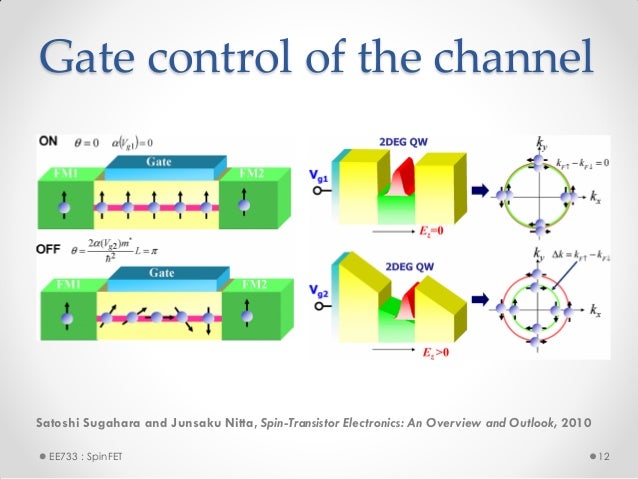Spin Field-Effect Transistor. The spin field-effect transistor (SpinFET) is a future semiconductor spintronics device promising to deliver a performance superior to that achieved with present transistor technology. A schematic illustration of the SpinFET is shown in Figure 8.1. SpinFETs are composed of two ferromagnetic contacts (source and drain), which sandwich the semiconductor region. Spin–orbit torque field-effect transistor (SOTFET): Proposal for a magnetoelectric memory Cite as: Appl. 116, 242405 (2020); doi: 10.1063/5.0002909.
Abstract
An analog of the Datta-Das spin field-effect transistor (FET) is investigated, which is all graphene and based on the valley degree of freedom of electrons/holes. The “valley FET” envisioned consists of a quantum wire of gapped graphene (channel) sandwiched between two armchair graphene nanoribbons (source and drain), with the following correspondence to the spin FET: valley (K and ) ↔ spin (up and down), armchair graphene nanoribbons ↔ ferromagnetic leads, graphene quantum wire ↔ semiconductor quantum wire, valley-orbit interaction ↔ Rashba spin-orbit interaction. The device works as follows. The source (drain) injects (detects) carriers in a specific valley polarization. A side gate electric field is applied to the channel and modulates the valley polarization of carriers due to the valley-orbit interaction, thus controlling the amount of current collected at the drain. The valley FET is characterized by (i) smooth interfaces between leads and the channel, (ii) strong valley-orbit interaction for electrical control of drain current, and (iii) vanishing interband valley-flip scattering. By its analogy to the spin FET, the valley FET provides a potential framework to develop low-power FETs for graphene-based nanoelectronics.
Pure spin current induced by a conventional charge current in a fully separated path. Spin FET working at room temperature under atmospheric conditions. Ohmic contact between SWNT and Mo is an efficient spin injector/detector. R spin can be modulated with gate voltages and external magnetic fields.
Spin Fet Pdf

- Received 27 July 2012
DOI:https://doi.org/10.1103/PhysRevB.86.165411
©2012 American Physical Society
Abstract
Spin Field Effect Transistor
An analog of the Datta-Das spin field-effect transistor (FET) is investigated, which is all graphene and based on the valley degree of freedom of electrons/holes. The “valley FET” envisioned consists of a quantum wire of gapped graphene (channel) sandwiched between two armchair graphene nanoribbons (source and drain), with the following correspondence to the spin FET: valley (K and ) ↔ spin (up and down), armchair graphene nanoribbons ↔ ferromagnetic leads, graphene quantum wire ↔ semiconductor quantum wire, valley-orbit interaction ↔ Rashba spin-orbit interaction. The device works as follows. The source (drain) injects (detects) carriers in a specific valley polarization. A side gate electric field is applied to the channel and modulates the valley polarization of carriers due to the valley-orbit interaction, thus controlling the amount of current collected at the drain. The valley FET is characterized by (i) smooth interfaces between leads and the channel, (ii) strong valley-orbit interaction for electrical control of drain current, and (iii) vanishing interband valley-flip scattering. By its analogy to the spin FET, the valley FET provides a potential framework to develop low-power FETs for graphene-based nanoelectronics.
- Received 27 July 2012
Spin Fet

Boba Fett Spin Off Series
DOI:https://doi.org/10.1103/PhysRevB.86.165411

Spin Transistor
©2012 American Physical Society
